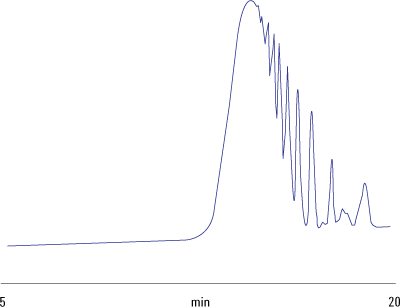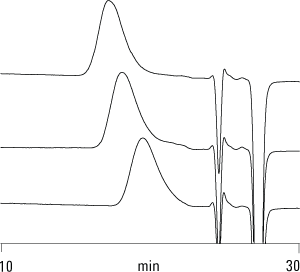Access Agilent eNewsletter, August 2013
>> Update My Profile | Subscribe to Access Agilent | Article Directory

GPC/SEC analysis of polymers derived from petrochemicals
By Ben MacCreath
Agilent Product Manager
Crude oil, or petroleum, is the main source of organic polymeric chemicals for industry. These chemicals are derived from two major constituents of oil: olefins – including ethylene and propylene, and aromatics – such as benzene, toluene, and xylene. Once these raw materials are extracted, they are broken down into more basic polymers such as polyethylene, polypropylene, elastomers, asphalts, and liquid hydrocarbons. Millions of tons of these compounds are produced and used worldwide every year.
Strike a balance through polymer analysis
There are several key physical parameters observed with these materials – strength, brittleness, melt flow, and ease of processing – which are influenced by both molecular weight and molecular weight distribution. These two crucial factors are determined by analyzing the polymers using gel permeation chromatography/size exclusion chromatography (GPC/SEC), making it a critical technique for companies that synthesize polymers or employ them in their formulations.
In general, increasing the molecular weight will lead to greater strength, but this increase comes with a corresponding decrease in processability. You can improve processability with an increase in the width of the distribution – but then strength will suffer. This means a careful balance between the two parameters must be struck and analysis by GPC/SEC is crucial in correlating performance to the weight and distribution of the polymer.
Apply GPC/SEC to all polymers, even the toughest
Industrial intermediate or pre-polymers are analyzed by GPC/SEC using a range of solvents and temperatures. Certain polymers such as phenol-formaldehyde resins can be characterized at near-ambient temperatures on a straightforward LC system such as the Agilent 1260 Infinity GPC/SEC System with no sample pretreatment. Other polymers, such as engineering polymers, are particularly difficult to analyze. They are usually tough and hard to dissolve and therefore require aggressive solvents, extensive sample prep, and elevated temperatures. For these applications at high temperature, a high performance integrated GPC system is a necessity.
Here we highlight a couple of key applications for these important industries, taken from Agilent’s new GPC application compendium for energy and chemicals.
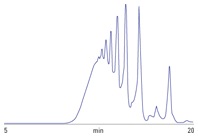 Enlarge
Enlarge
Figure 1. Chromatogram of a polyurethane sample with oligomers and residual monomers.
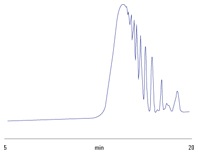 Enlarge
Enlarge
Figure 2. Chromatogram of a polyester sample showing oligomeric detail.
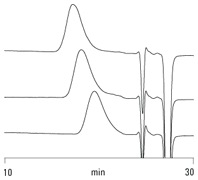 Enlarge
Enlarge
Figure 3. Overlaid chromatograms of three samples of polyphenylene sulfide.
Determining Oligomer composition with the Agilent PlusPore columns
Both the composition of oligomers in resins and the determination of residual monomer in the quality control of polymers are of great commercial importance, ideally, separation of discrete components is required to identify and quantify the specific components of interest. To achieve this, small particle size packings are used to produce high resolution separations. A typical application chromatogram is shown in Figure 1.
When working with resins that have a higher and broader molecular weight, a column with a larger resolving range is required. The Agilent ResiPore column has been specifically designed for applications where high resolution of material under 400,000 molecular weight is required. Figure 2 is a typical application chromatogram.
A unique solution for the analysis of engineering polymers
Engineering polymers have high strength and toughness as a result of their high molecular weight and/or crystalinity. Greater molecular weight requires untangling longer molecular chains in order to dissolve the material; greater crystalinity requires the break-up of any inter-chain bonds that may be present.
Polyphenylene sulfide (PPS) has a rigid backbone of alternating aromatic rings linked by sulfur atoms. It is useful as a structural material due to its high resistance to both chemical and thermal attack, because the material is very stiff, even at high temperatures. PPS is used in a number of applications, including as a filter fabric for coal boilers, in felts used in paper making, in electrical insulation applications and in the manufacture of specialty membranes. PPS is naturally insulating, although the addition of a dopant can be used to make the material semiconducting. PPS is particularly difficult to analyze by GPC. The high chemical and thermal resistance of the material means that it is only soluble in specialist solvents such as ortho-chloronaphthalene at elevated temperatures of above 200 °C (Figure 3). Agilent’s PL-GPC 220 High Temperature GPC/SEC System is the only system capable of analyzing these polymers under these conditions, and the PLgel column material maintains performance at high temperature.
Explore Agilent’s energy and chemicals solutions
Do you have a tough analytical problem to solve? Then it’s time to explore the new Agilent GPC application portfolio where you’ll find many more energy and chemical applications, together with advice on selecting the right system for your application. Of course, additional information regarding Agilent’s comprehensive family of GPC columns, standards, and instruments are always available. So start exploring these valuable solutions today.
>> Update My Profile | Subscribe to Access Agilent | Article Directory
Figure 1.
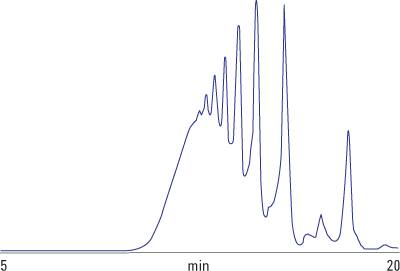
Conditions |
|
|---|---|
Columns |
2 x Agilent MesoPore, 7.5 x 300 mm (p/n PL1113-6325) |
Eluent |
THF |
Flow rate |
1.0 mL/min |
Injection volume |
20 µL |
Instrument |
1260 Infinity GPC/SEC System |
Detector |
RID |
Chromatogram of a polyurethane sample with oligomers and residual monomers.
